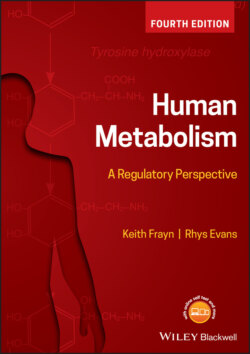Читать книгу Human Metabolism - Keith N. Frayn - Страница 26
1.3.1.1 Energy transduction
ОглавлениеChemical energy transduction is the process of transferring energy between different forms, and involves two main biochemical energy carrier types: (i) ATP (and also, less ubiquitously, GTP and creatine phosphate) which carries energy in the form of ‘high energy’ phosphate groups and (ii) NADH, NADPH, and FADH2, which carry energy in the form of an electron (actually, as discussed above, a hydrogen atom with an extra electron – a hydride ion: H−). The energy status of the cell may be quantified with either of these systems – hence, (i) the ‘energy charge’ (phosphorylation potential) of the cell is an index of the degree of ATP phosphorylation (the amount of AMP that is phosphorylated to ADP and ATP: = [ATP] + [½ADP] ÷ [ATP] + [ADP] + [AMP]), and (ii) the ‘redox potential’ of the cell denotes the degree of reduction of NAD+ (i.e. the NADH:NAD+ ratio) and NADP+ (NADPH:NADP+). Besides carrying energy ‘down’ (catabolism) or ‘up’ (anabolism) metabolic pathways (Figure 1.12), the energy charge/phosphorylation potential and redox potential are major regulators of metabolic pathways to ensure appropriate energy provision.
